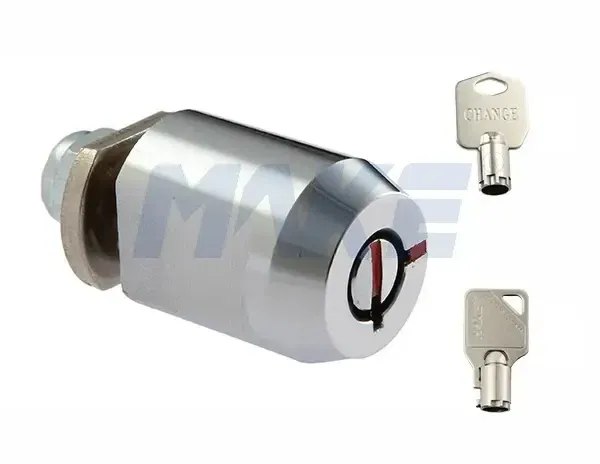Tubular cam locks — sometimes known as circle pin tumbler locks, radial locks, or Ace locks — are a familiar sight in everyday security: vending machines, lockers, display cases, coin boxes and cabinets often rely on their compact cylindrical form and distinctive round key. Their design offers convenience and, for many low-to-medium security applications, sufficient protection. But as demand for secure small-format locking solutions grows, so does the need to understand how these locks work, how they should be installed and maintained, and what owners should do to maximize their security.
This article outlines the essential facts about tubular cam locks for buyers, facility managers, and everyday users. It explains how the locks operate, gives clear installation and maintenance guidance, highlights where manufacturers have improved security, and offers practical advice for preventing unauthorized access — all while steering clear of any instructions that could facilitate misuse.
A tubular cam lock is built around a cylindrical body with a circular keyway at one end and a cam — a rotating metal arm — at the other. When the proper key is inserted and turned, internal components align to allow the cam to rotate and either engage or disengage the locking mechanism. The cam connects the cylinder to the latch, bolt, or other mechanical interface that secures a drawer, door, or panel.
The distinctive round key and compact profile make these locks particularly suitable where space is limited and a low-profile aesthetic is desired. They strike a balance between convenience and security and are commonly specified in retail, hospitality, vending and equipment enclosures.

Internally, tubular cam locks use radial pin elements positioned around a circular plug. When the correct key enters the round keyway, it pushes those pins to align with the shear line, allowing the plug to rotate within the cylinder. Rotating the plug turns the cam, which then locks or unlocks the mechanism attached to it.
That basic operation is common to a wide range of tubular locks, though manufacturers vary pin counts, tolerances, materials, key profiles and anti-tamper features. Higher pin counts, tighter manufacturing tolerances and hardened metals are common ways to improve resistance to unauthorized manipulation and wear.
Tubular cam locks are found across numerous sectors thanks to their small size and practical functionality:
Vending machines and kiosks: Their low profile and reliable operation make them a popular choice.
Cabinets and lockers: Office furniture, tool cabinets and gym lockers often use tubular cam locks.
Display cases and point-of-sale equipment: Where a neat, unobtrusive lock is needed.
Coin boxes, meter enclosures and arcade machines: Devices requiring frequent but controlled access.
Industrial equipment panels: For limited access to service panels or consumable compartments.
In commercial deployments, locks are often keyed to master systems or supplied as part of a larger access control plan.
Installation of a tubular cam lock is straightforward, but doing it correctly ensures security and longevity:
Most tubular cam locks fit a standard diameter hole. Check the lock’s datasheet for the exact size and tolerance. Where possible, use the manufacturer’s template to make a clean, accurate cut.
Slide the lock into the prepared aperture so the keyway faces outward and the cam location aligns with the intended mechanical interface.
Most cam locks are fixed in place with a nut, clip or retaining ring supplied with the lock. Tighten these to the manufacturer’s torque specification to prevent rotation of the body while keeping weather seals intact.
Fasten the cam lever or tailpiece to the rear of the cylinder, ensuring it matches the orientation required to engage the strike or latch. Some cams are reversible to accommodate left- or right-hand installations.
Verify smooth key insertion, rotation and cam engagement. Cycle the lock several times to ensure no binding and that the cam clears the strike plate or receiver.
For outdoor or damp installations, fit gaskets or use weatherproof models rated for the environment. Proper sealing prolongs service life and prevents corrosion.
If you’re installing multiple locks that must be keyed alike or integrated into existing systems, plan key codes and master keying with your supplier in advance.
Choosing the right lock involves more than picking a round key. Consider these factors:
Indoor office furniture has different needs than outdoor vending equipment. Look for corrosion-resistant finishes and IP ratings where moisture is a factor.
Standard tubular cam locks suit low-to-medium security needs. For higher security, select models with increased pin counts, restricted key profiles or hardened components.
If unauthorized key duplication is a concern, choose locks with restricted keyways and patented key profiles that limit who can reproduce keys.
For commercial properties, master-key systems offer convenient hierarchical access but must be designed carefully to avoid security holes.
Hardened steel cams and brass or stainless steel cylinders are more durable and resist wear from frequent use.
Consider ease of rekeying and availability of replacement cores or cams over the product lifetime.
Discussing use case and lifecycle costs with the lock supplier helps ensure the right balance between cost and performance.
Tubular cam locks provide efficient, compact security for many applications, but like all mechanical locks they have tradeoffs.
Compact, unobtrusive design ideal for small enclosures.
Simple operation and rapid access management (especially in keyed-alike systems).
Readily available and cost-effective for low-risk installations.
Some older or low-cost tubular locks can be more vulnerable to manipulation than modern, well-manufactured cylinders.
Economic models may use softer metals or tolerances that degrade faster under heavy use or harsh environments.
Key control is only as strong as the policy around key duplication and distribution.
To mitigate risk, owners should choose higher-quality locks with improved tolerances, use restricted key systems where appropriate, and combine mechanical locks with other deterrents such as tamper-resistant enclosures, surveillance and monitored access control.
Routine maintenance extends the life of a lock and prevents inconvenient failures:
Regular cleaning: Wipe the exterior and keyway to remove dust and grime. Use compressed air sparingly and avoid injecting lubricants into the keyway.
Lubrication: Use a dry lubricant formulated for locks (e.g., graphite or PTFE dry spray) if the key action becomes stiff. Avoid oil-based lubricants that attract dust.
Inspect for wear: Check cams, retaining nuts and mounting hardware for corrosion or loosening. Replace worn components promptly.
Corrosion control: For outdoor equipment, apply corrosion inhibitors to exposed hardware and ensure gaskets seal correctly.
Key care: Encourage users to avoid bending keys and to remove debris from pockets before inserting keys into the lock.
If a lock fails, consult a certified locksmith or the manufacturer for repair or cylinder replacement. For lost keys, follow organizational procedures for rekeying and revoking access rather than attempting insecure fixes.
Lock ownership carries responsibilities. Only authorized personnel should possess keys, and attempting to bypass locks without permission is illegal in most jurisdictions. If access is required and keys are missing, the right call is to contact the property owner or a licensed locksmith who can provide lawful entry and restore security.
For organizations, maintaining accurate key inventories, issuing keys on a need-to-know basis and promptly rekeying when staff leave are crucial elements of physical security policy.
Manufacturers are responding to market demands with several advances:
Enhanced mechanical tolerances for better resistance to wear and manipulation.
Restricted keyway systems to reduce unauthorized duplication.
Hybrid systems that pair mechanical tubular locks with electronic monitoring or remote notifications for greater security oversight.
Improved materials such as stainless or hardened alloys for outdoor durability.
These developments make modern tubular cam locks more robust for a wider variety of applications, from retail environments to light industrial deployments.
Consult a licensed locksmith or the lock manufacturer when:
You need to rekey multiple locks to a new code.
Locks exhibit repeated binding or corrosion.
You suspect a security breach or unauthorized key copying.
You want to integrate locks into a master-key or access control system.
Professionals provide lawful, durable solutions and help maintain the integrity of the property’s security posture.
Tubular cam locks are a practical, widely used locking solution that balances compact form with dependable performance. For many common uses — vending, cabinets, lockers and equipment housings — a well-selected tubular cam lock installed and maintained properly will provide years of reliable service. The keys to success are matching the lock design to the application, enforcing key control policies, scheduling routine maintenance, and calling professionals for repairs or security upgrades.
By understanding the strengths and limitations of tubular cam locks and following straightforward installation and care practices, organizations and individuals can ensure that these small but vital devices continue to protect assets effectively — without compromising safety or legal obligations.
